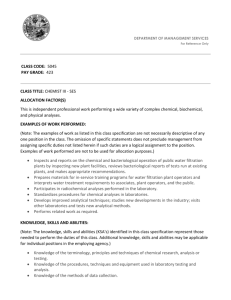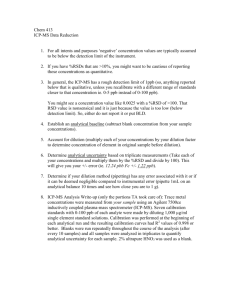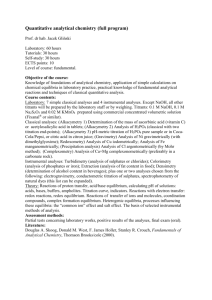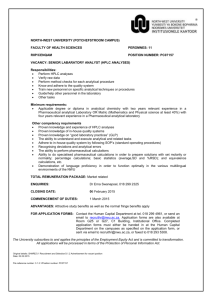ggge20816-sup-0001-2015GC005966-supinfo
advertisement
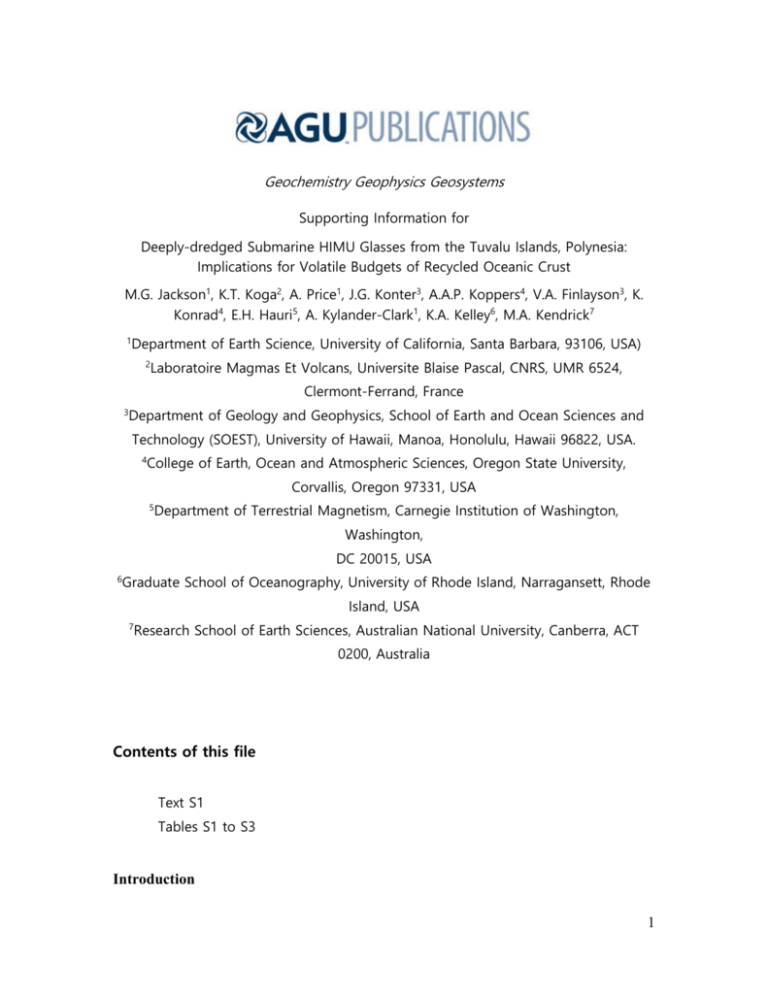
Geochemistry Geophysics Geosystems Supporting Information for Deeply-dredged Submarine HIMU Glasses from the Tuvalu Islands, Polynesia: Implications for Volatile Budgets of Recycled Oceanic Crust M.G. Jackson1, K.T. Koga2, A. Price1, J.G. Konter3, A.A.P. Koppers4, V.A. Finlayson3, K. Konrad4, E.H. Hauri5, A. Kylander-Clark1, K.A. Kelley6, M.A. Kendrick7 1 Department of Earth Science, University of California, Santa Barbara, 93106, USA) 2 Laboratoire Magmas Et Volcans, Universite Blaise Pascal, CNRS, UMR 6524, Clermont-Ferrand, France 3 Department of Geology and Geophysics, School of Earth and Ocean Sciences and Technology (SOEST), University of Hawaii, Manoa, Honolulu, Hawaii 96822, USA. 4 College of Earth, Ocean and Atmospheric Sciences, Oregon State University, Corvallis, Oregon 97331, USA 5 Department of Terrestrial Magnetism, Carnegie Institution of Washington, Washington, DC 20015, USA 6 Graduate School of Oceanography, University of Rhode Island, Narragansett, Rhode Island, USA 7 Research School of Earth Sciences, Australian National University, Canberra, ACT 0200, Australia Contents of this file Text S1 Tables S1 to S3 Introduction 1 The Supplementary Information included 4 files. First, the methods for geochemical analyses are provided. This file provides all information on how data were collected. In addition, three data tables are provided that give: 1.) the geochemical data obtained on new volcanic glasses from the Tuvalu islands, 2.) geochemical data obtained on standard glasses and, 3.) halogen element concentrations obtained on glasses from the Tuvalu Islands. Text S1. This file provide all methods employed for geochemical analyses in this study. Table S1. Major, trace and volatile element concentrations and Pb-isotopic ratios on glasses from the Tuvalus collected on the 2013 cruise of the R/V Roger Revelle (cruise RR1310). Table S2. Major, trace and volatile element and volatile element and Pb-isotopic analyses of glasses (measured as secondary standards) performed during the same analytical session as the Revelle 1310 glass samples reported here. Table S3. Halogen data obtained by the noble gas method (including 2σ analytical uncertainty) Supporting Information Methods 1. Major elements The glasses were characterized for their major element compositions using the Cameca SX-100 electron microprobe housed at UC Santa Barbara. All major element analyses of unknowns were made in triplicate, and the average values for the Tuvalu glasses are reported in supporting information Table 1. The totals for some glass analyses 2 are slightly low, and this owes to high volatile (H2O, Cl, S, etc.) and trace element (Ba, Sr, etc.) concentrations in the glasses that are not included in the totals, as volatile and trace element concentrations were not measured by electron probe. During measurement, a 10 µm defocused beam with a 15 kV accelerating voltage and a 15 nA current was used. Primary standardization for the major elements employed the following standards: ScPO4 (USNM168495) for P standardization, orthoclase (MAD-1) for K, albite (Cazadero) for Al and Na, diopside (Chesterman) for Si and Mg, basaltic glass (USNM113498) for Fe and Ca, synthetic MnO for Mn, and synthetic TiO2 for Ti. A ZAF (Armstrong, 1988) matrix correction was used. A MORB glass sample (ALV-519-4-1) was repeatedly analyzed as a secondary standard over the course of the analytical session, and the major element compositions of the ALV-519-4-1 MORB glass analyses are reported in supporting information Table S2. In Table S2, a prior analysis of ALV-519-41 reported in Melson et al. (2002) is also shown for comparison. 2. Trace elements The trace element analyses reported here were measured in the same analytical session, and used the same standardization, as LA-ICP-MS (laser ablation inductively coupled mass spectrometer) data reported in Cabral et al. (2014). Trace elements were measured at the University of Rhode Island using the New Wave UP213 Nd-YAG laser and Thermo X-Series II quadrupole ICP-MS. Analytical techniques for laser ablation are outlined in Kelley et al. (2003) and Lytle et al. (2012). All analyses of unknowns were made with an 80 µm laser spot and a 10 Hz repeat rate. Data were normalized to 43Ca as the internal standard, and Ca concentrations were determined by electron microprobe (see 3 above). As noted in Cabral et al. (2014), the calibration curves were linear (r2 > 0.99 for all elements reported). The Tuvalu glasses were measured in triplicate, and the average compositions are reported in supporting information Table S1. The MORB glass sample ALV-519-4-1 was analyzed nine times over the course of the analytical session, and the trace element concentrations are within 7% of the concentrations reported for this glass in Gale et al. (2013), except for concentrations of Sc (9.1%), Cr (21.2%), Co (8.5%), Ni (19.4%), Cs (17%), Th (9.6%), Pb (13.5%), Sr (11.1%), Hf (11.7%), Y (16%) and Lu (9.8%) (Table S2). Spinels, olivines and sulfides are largely avoided during laser ablation. However, Gale et al. (2013) employed solution-based ICP-MS trace element analyses of ALV-519-4-1, which may explain some of the disagreement with the laser ablation-based measurements made here: the higher Cr and Ni concentrations in the solution-based analysis may relate to bulk dissolution of spinel and olivine, and higher Pb concentrations may be a result of bulk dissolution of sulfide hosted in the glass (which is supported by slightly higher Cu in the Gale et al. [2013] analysis). In addition to analyses of ALV-519-4-1, an incompatible element enriched glass from the Easter-Salas y Gomez seamount chain, GL07-D52-5, was analyzed four times over the course of the analytical session. The trace element concentrations of GL07-D525 are within 7% of the concentrations reported by solution-based ICP-MS for this glass by Kelley et al. (2013), except for Cr (37.9%), Co (23.7%), Ni (91.6%), Cu (10.4%), Cs (22.4%), Ta (13.7%), Hf (9.4%) and Er (8%) (supporting information Table S2). The elevated Cr, Co, Ni and Cu may relate to the incorporation of trace phases (spinel and sulfide) in the bulk dissolution of glass for solution-based ICP-MS analyses, while these phases are largely avoided during laser ablation. 4 3. Ion microprobe determination of CO2, H2O, Cl, F, S Volatile element analyses were made using the Cameca IMS 6f ion microprobe at the Department of Terrestrial Magnetism (DTM), Carnegie Institution of Washington following methods outlined in Hauri et al. (2002). A Cs+ primary beam (14 nA) was used and charge build-up was compensated with an electron gun. Each glass was analyzed in triplicate, and average analyses are reported in supporting information Table S1. Prior to analysis, the beam was rastered (75 µm raster) over the sample surface for 300 seconds to clean the surface of potential contaminants. The volatile analyses reported here were made during the same analytical session as the volatile element data reported in Cabral et al. (2014), and use the same primary and secondary standards analyses. ALV-519-4-1 was used as a secondary standard to correct for drift during the analytical session. Submarine glass sample GL07-D52-5 was analyzed as an unknown during the same analytical session as the Tuvalu glasses (see supporting information Table S2), and the analyses of GLO7-D52-5 are also reported in Jackson et al. (2015). CO2 and H2O concentrations of GL07-D52-5 are also reported in Simons et al. (2002), and are shown in supporting information Table S2 for comparison; prior analyses of Cl, F and S concentrations of GL07-D52-5, also shown in supporting information Table S2, are based on a long-term analytical campaign at DTM focused on characterizing the volatile concentrations of this glass sample (Hauri, unpubl.). The 2σ error of the mean for the volatile analyses is the following: < 6% for H2O; < 5% for CO2, F, and Cl; < 3% for S. 4. Determination of Cl, Br and I by the noble gas method 5 The noble gas method for halogen determination exploits neutron activation which converts a small portion of the samples Cl, Br, I and K into noble gas proxy isotopes (38ArCl, 80KrBr, 128XeI and 39ArK) that can be precisely measured by noble gas mass spectrometry. The method represents an extension of the 40Ar-39Ar dating methodology (see Kendrick, 2012; Kendrick et al., 2013). Small aliquots of the current samples (5.2 mg of D10-36 and 7.5 mg of D10-48) where irradiated for 50 hours in the Central Facility of the research reactor at the McClellan Nuclear Radiation Center, University of California Davis, California, on the 23rd August 2014 (Irradiation RS#1). The samples received a total neutron fluence of 3.7×1018 neutrons cm-2, with a fast/thermal ratio of 1 (J = 0.00957). Noble gas production ratios (K/39ArK, Ca/37ArCa, Cl/38ArCl, Br/80KrBr and I/128XeI) were monitored using the Hb3Gr 40Ar/39Ar flux monitor (1072 Ma; Roddick, 1983) and a set of three scapolite standards characterized for Cl, Br and I (Kendrick, 2012; Kendrick et al., 2013). Following irradiation and return of the sample package to the Australian National University (ANU), the samples were unpacked and loaded into Sn-foil capsules in an ultra-high vacuum sample holder attached to an extraction line connected to the MAP215 noble gas mass spectrometer at the ANU. The samples were dropped into a tantalum resistance furnace and the sample gas was extracted by heating the samples to 1500 °C. The sample gas was purified over a period of 40 minutes using a Ti-foil bulk getter and series of SAES getter pumps. The purified noble gas was then admitted to the MAP-215 noble gas mass spectrometer and analyzed for isotopes of Ar, Kr and Xe in peak jumping mode over a period of 50 minutes. 6 Analytical precision is at the 1-2% level (2σ). Br/Cl and I/Cl ratios have reproducibilities between irradiations of 5% for Br/Cl and 10% for I/Cl (limited by the homogeneity of scapolite standards). The absolute accuracy of concentrations (external precision) is estimated as 10% for all elements. The methods have been described in detail elsewhere (see Kendrick, 2012; Kendrick et al., 2013). Note that Cl concentrations determined by ion probe are consistent with the Cl concentrations obtained by the noble gas method. Assuming 10% uncertainty on the Cl determinations by the noble gas method, and quoted uncertainties on ion probe method, the Cl concentrations are indistinguishable within analytical uncertainty. 5. Pb isotopes In situ Pb-isotopic compositions were measured by LA-ICP-MS following a procedure outlined by Kylander-Clark et al. (2013). A Photon Machines Excite excimer laser was coupled with the Nu Plasma HR (high resolution) multi-collector ICP-MS housed at UC Santa Barbara. Laser ablation employed a 110 µm spot, a rep-rate of 20 Hz and a fluence of ~2 J/cm2. Intensities on masses 206, 207 and 208 were measured by static multicollection on three Faraday collectors. Prior to beginning the laser ablation analytical session, each spot (standards and unknowns) selected for analysis was preablated with 5 pulses using a 150 µm spot with the same laser fluence; during the analytical session, each spot was pre-ablated again in the same manner with 5 pulses approximately 30 seconds prior to analysis. Background Pb intensities were measured for 20 seconds prior to ablation, followed by 25 seconds of analysis; background intensities on the relevant masses were subtracted from the intensities measured during ablation. 7 Analyses of GOR-132G, KL2-G, ML3-B and StHs6/80 reference materials were interspersed throughout the analytical session. A single analysis of GOR132-G and of KL2-G was made between every unknown, and analyses of additional reference (ML3-B and StHs6/80) materials were made between every four unknowns. Data was reduced with Iolite software (Paton et al., 2011; Paul et al., 2011) using a sample-standard bracketing technique with the GOR132-G reference glass as the primary reference material for correction of Pb isotopic fractionation during analysis of unknowns. GOR132-G was analyzed 44 times over the course of the analytical session; the suggested Pb-isotopic values for GOR132-G (207Pb/206Pb = 0.8167 and 208Pb/206Pb = 2.0111) are taken from Jochum et al. (2011). The following show the 207Pb/206Pb and 208 Pb/206Pb ratios measured in secondary reference standards over the course of the analytical session: KL2-G (0.8210 ± 0.0028 and 2.0231 ± 0.0051, 2σ standard deviation, n=25 separate analyses), ML3-B (0.8304 ± 0.0061 and 2.0489 ± 0.0066, n=7) and StHs6/80 (0.8257 ± 0.0011 and 2.0368 ± 0.0017, n=7). The following Pb-isotopic values have been suggested for these reference materials (Jochum et al., 2011): 207Pb/206Pb = 0.8216 and 208Pb/206Pb = 2.0247 for KL2-G; 0.8338 and 2.0546 for ML3-B; 0.8264 and 2.0383 for StHs6/80. The Pb concentrations of the primary standard (GOR132-G, 19.5 ppm Pb) and the secondary standards (KL2-G [2.07 ppm]; ML3B-G [1.38 ppm]; StHs6/80-G [10 ppm]) are similar to the range of concentrations that we report in the Tuvalu glasses (0.9 to 12.7 ppm Pb), and we argue that the external precision that we achieved by repeated analysis of the reference materials reflects the external precision that we achieved on the unknown glasses (Jochum et al., 2006). Within the quoted uncertainty, the measured 207Pb/206Pb and 208Pb/206Pb ratios agree with the suggested 8 values for each reference materials. The difference between the suggested (Jochum et al., 2006) and measured 207Pb/206Pb and 208Pb/206Pb ratios generally increases with decreasing Pb-concentrations in the secondary reference materials, including StHs6/80 (820 ppm disagreement for 207Pb/206Pb and 710 ppm for 208Pb/206Pb) KL2-G (790 ppm and 770 ppm), and ML3-B (4120 ppm and 2760 ppm). It is notable that the five glasses in this study with the strongest HIMU signature (two from dredge 5 and three from dredge 10) have the highest Pb concentrations (6.3 to 12.7 ppm Pb) and these measurements have the best in-run precision among the glasses reported in this study. All unknowns were measured in duplicate and the average values are reported in supporting information Table S2. During the analytical session, intensities for GOR132-G varied from 126 to 179 mV (on 1011 Ω amplifiers) on mass 208. 204Pb measurements are not reported owing to difficulties associated with correcting for the isobaric interference from 204Hg during Pb-isotopic analysis by LA-ICP-MS (Paul et al., 2011). References Cited: Armstrong, J.T. (1988), Quantitative Analysis of Silicate and Oxide Materials: Comparison of Monte Carlo, ZAF, and Φ(ρ,Z) Procedures, In: Microbeam Analysis1988, Ed. DE Newbury. San Francisco Press, San Francisco, pp. 239-246. Cabral, R.A., M.G. Jackson, K.T. Koga, E.F. Rose-Koga, E.H. Hauri, M.J. Whitehouse, A.A. Price, J.M.D. Day, N. Shimizu, and K.A. Kelley (2014), Volatile cycling of H2O, CO2, F, and Cl in the HIMU mantle: A new window provided by melt inclusions from oceanic hotspot lavas at Mangaia, Cook Islands, Geochemistry, Geophysics, Geosystems, 15. doi: 10.1002/2014GC005473 Gale, A., M. Laubier, S. Escrig, and C. H. Langmuir (2013), Constraints on melting processes and plume-ridge interaction from comprehensive study of the FAMOUS and North Famous segments, Mid-Atlantic Ridge, Earth Planet. Sci. Lett., 365, 209–220, doi:10.1016/ 801j.epsl.2013.01.022. Hauri, E., J. Wang, J.E. Dixon, P.L. King, C. Mandeville, and S. Newman (2002), SIMS 9 analysis of volatiles in silicate glasses 1. Calibration, matrix effects and comparisons with FTIR, Chem. Geol., 183, 99-114. Jackson, M.G., R.A. Cabral, E.F. Rose-Koga, K.T. Koga, A. Price, E.H. Hauri, P. Michael. An ultra-depleted mantle component in the Ontong Java Plateau revealed by major, trace and volatile element abundances in olivine-hosted melt inclusions. Submitted to Chem. Geol., March 2015. Jochum, K.P., B. Stoll, K. Herwig, M. Willbold, A.W. Hofmann, M. Amini, S. Aarburg, W. Abouchami, E. Hellebrand, B. Mocek, I. Raczek, A. Stracke, O. Alard, C. Bouman, St. Becker, M. Dücking, H. Brätz, R. Klemd, D. de Bruin, D. Canil, D. Cornell, J.C.M. de Hoog, C. Dalpé, L.V. Danyushevsky, A. Eisenhauer, Y. Gao, J.E. Snow, N. Groschopf, D. Günther, C. Latkoczy, M. Guillong, E. Hauri, H.E. Höfer, Y. Lahaye, K. Horz, D.E. Jacob, S. Kasemann, A.J.R. Kent, T. Zack, T. Ludwig, P.R.D. Mason, A. Meixner, M. Rosner, K. Misawa, B.P. Nash, J.A. Pfänder, W.R. Premo, D. Sun Weidong, M. Tiepolo, R. Vannucci, T. Vennemann, D. Wayne and J.D. Woodhead (2006), MPI-DING reference glasses for in situ microanalysis: New reference values for element concentrations and isotope ratios. Geochem. Geophy. Geosyst., 7, Q02008. Jochum, K.P., S.A. Wilson, W. Abouchami, M. Amini, J. Chmeleff, A. Eisenhauer, E. Hegner, L.M. Iaccheri, B. Kieffer, J. Krause, W.F. McDonough, R. Mertz-Kraus, I. Raczek, R.L. Rudnick, D. Scholz, G. Steinhoefel, B. Stoll, A. Stracke, S. Tonarini, D. Weis, U. Weis and J.D. Woodhead (2011), GSD-1G and MPI-DING Reference Glasses for In Situ and Bulk Isotopic Determination, Geostandards and Geoanalytical Research 35, 193–226. Kamenetsky, V. S. and S.M. Eggins (2012), Systematics of metals, metalloids, and volatiles in MORB melts: Effects of partial melting, crystal fractionation and degassing (a case study of Macquarie Island glasses), Chem. Geol., 302, 76-86. Kelley, K.A., T. Plank, J. Ludden, and H. Staudigel (2003), Composition of altered oceanic crust at ODP Sites 801 and 1149, Geochem. Geophy. Geosy., 4, doi: 10.1029/2002GC000435. Kelley, K.A., R. Kingsley, and J.-G. Schilling (2013), Composition of plume-influenced mid-ocean ridge lavas and glasses from the Mid-Atlantic Ridge, East Pacific Rise, Galápagos Spreading Center, and Gulf of Aden. Geochem. Geophys. Geosyst., 14, doi:10.1029/2012GC004415 Kendrick, M.A. (2012), High precision Cl, Br and I determination in mineral standards using the noble gas method. Chem. Geol., 292–293, 116–126. Kendrick, M.A., R.J. Arculus, P. Burnard, M. Honda (2013), Quantifying brine assimilation by submarine magmas: examples from the Galápagos Spreading Centre and Lau Basin, Geochim. Cosmochim. Acta123, 150–165. Kendrick, M.A., M.G. Jackson, E.H. Hauri, D. Phillips (2015), The halogen (F, Cl, Br, I) 10 and H2O systematics of Samoan lavas: assimilated-seawater, EM2 and high-3He/4He components, Earth Planet. Sci. Lett., 410, 197-209. Kylander-Clark, A.R.C., B.R. Hacker, and J.M. Cottle (2013). Laser-ablation split-stream ICP petrochronology, Chem. Geol., 345, 99-112. Lytle, M.L., K.A. Kelley, E.H. Hauri, J.B. Gill, D. Papia, and R.J. Arculus (2012), Tracing mantle sources and Samoan influence in the northwestern Lau back-arc basin: Geochem. Geophy. Geosy., 13, doi: 10.1029/2012GC004233. Melson, W.G., T. O'Hearn, and E. Jarosewich (2002), A data brief on the Smithsonian Abyssal Volcanic Glass Data File, Geochem. Geophy. Geosy., 3, 1-11, doi: 10.1029/2001GC000249. Michael, P. J., and W.C. Cornell (1998), Influence of spreading rate and magma supply on crystallization and assimilation beneath mid-ocean ridges: Evidence from chlorine and major element chemistry of mid-ocean ridge basalts, J. Geophys. Res., 103, 18,325– 18,356. Paton, C., J.C. Hellstrom, B. Paul, J.D. Woodhead, J.M. Hergt (2011), Iolite: freeware for the visualization and processing of mass spectrometric data. J. Analytical Atomic Spectrometry, 26, 2508-2518. Paul, B., J.D. Woodhead, J. Hergt, L. Danyushevsky, T. Kunihiro, and E. Nakamura (2011), Melt inclusion Pb-isotope analysis by LA–MC-ICPMS: Assessment of analytical, performance and application to OIB genesis, Chem. Geol. 289, 210–223. Roddick, J.C. (1983), High precision intercalibration of 40Ar–39Ar standards, Geochim. Cosmochim. Acta, 47, 887–898. Simons, K., J. Dixon, J.-G. Schilling, R. Kingsley, and R. Poreda (2002), Volatiles in basaltic glasses from the Easter-Salas y Gomez Seamount Chain and Easter Microplate: Implications for geochemical cycling of volatile elements, Geochem. Geophy. Geosy., 3, 1-29, doi: 10.1029/2001GC000173. Stroncik, N. A., and K. M. Haase (2004), Chlorine in oceanic intraplate basalts: Constraints on mantle sources and recycling processes, Geology, 32, 945-948, doi:10.1130/G21027.1. 11



